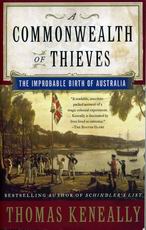
Commonwealth of Thieves
The Improbable Birth of Australia
Keneally, Thomas
Publisher: Anchor Books
Year First Published: 2005
Year Published: 2006
Pages: 385pp ISBN: 978-1-4000-7956-8
Library of Congress Number: DU99.K46 2006 Dewey: 994.02
Resource Type: Book
Cx Number: CX11654
A history of the first four years of the convict settlement in Australia, examining the interplay of soldiers, convicts, and Aborigines.
Abstract:
Covering the initial four years of Australia's controversial settlement, Thomas Keneally's A Commonwealth of Thieves: The Improbable Birth of Australia, examines the hardships faced by the colony's first governor, Arthur Phillips. Documenting the journey from British prisons to the penal colonies of the South Seas, Keneally's work sets out to explain how an improbable solution to a social issue created what would become a wealthy and profitable nation of the British Empire. A Commonwealth of Thieves begins by framing the backdrop of the British justice system during the final decades of the eighteenth century. Troubled with overcrowding in prisons, recovering from the American revolution and burdened with financial debts, the author analyzes how the creation of the Australian penal colony became a quick solution to ease both the financial and penitentiary woes of the British government.
Keneally presents an overview of the role of indentured servitude and prisoner relocation programs in the Americas from the early 1700s to the creation of the Australian colony in 1788. The author also discusses how other European nations, since the sixteenth century, turned to the new world as a destination to ship their inmates. The difference between earlier missions and the Austrian settlement, Keneally says, is the ability of the British to build a functioning and highly disciplined penal colony. The role of the British army, under the command of Arthur Phillips from 1788 until 1792, set the rigid tone for the following years of the colony's expansion.
The author's analysis and attention to minute detail presents the reader with a plethora of valuable information. Relying on letters, official reports and a variety of both primary and secondary resources, the author's extensive research illuminates the turbulent environment faced in the early years of the expedition. Struggling to combat disease, fighting with the Aboriginal population and subduing prisoner unrest are symbolized by Keneally as the hasty beginnings of what would become an improbable, yet vibrant region of the British Empire.
[Abstract by William Stevenson]
Subject Headings


